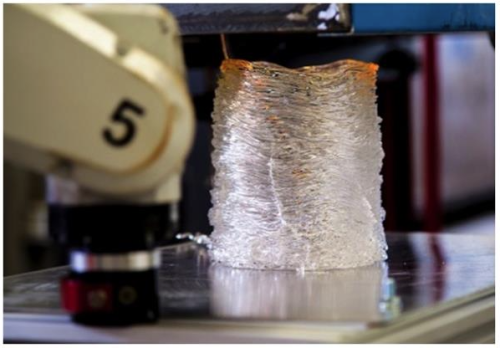Printing In Glass

Latest News
January 14, 2016
Researchers at Virginia Tech and the Rhode Island School of Design have created a crude (but effective) 3D glass printer. The system can print objects using a robotic arm that moves a tile around under an extruder that layers molten glass on to the tile. While the printer can’t create very complex or high-resolution objects, it’s a first step in printing with a fairly volatile material.
Creating glass art takes a lot of heat; glass blowing furnaces run at about 2000°F. While the new process won’t put any glass blowers out of business, it does offer a new way to create with glass in a more automated fashion.
RISD’s Stefanie Pender and Virginia Tech architecture professor Nathan King have been working together since 2013 via the Glass Robotics Lab to create robotically actuated molds, 3D printing solutions, and other fabrication processes.
The six-axis glass printing process was first developed in 2013. While the process has continued to improve, most of the printed objects are fairly rough looking because the glass cools unevenly.
“This research is an example of innovation that can occur at the intersection of art, design, technology, and science,” said Pender, a glass artist at RISD. “Instead of a technology-driven approach, we can approach digital fabrication from a place of profound material understanding. This research is evidence that the traditional technical arts will not be replaced by digital fabrication, instead, the technical arts will help to drive and support the direction of future making.”
Researchers at MIT’s Mediated Matter Group also created a 3D glass printing process that coils molten glass strands on top of one another. The optically transparent glass printing process, called G3DP, and operates at 1900°F.
Source: Tech Crunch
Subscribe to our FREE magazine, FREE email newsletters or both!
Latest News
About the Author
Brian Albright is the editorial director of Digital Engineering. Contact him at [email protected].
Follow DERelated Topics






